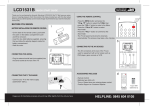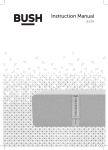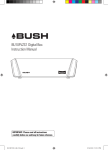Download Binatone TERRAIN 650 User guide
Transcript
LATITUDE 650 Private Mobile Radio ((PMR( USER GUIDE Antenna V OL(Volume) button - Press to adjust the speaker volume level Ear/Mic jack PTT (PUSH to TALK) button - Press and hold to transmit. Belt clip latch 2. Installation Charging the Rechargeable Battery pack continued... 2.1 Removing the Belt Clip a. Pull the Belt Clip Latch away from the PMR. b. While pulling the Belt Clip Latch, push the Belt Clip up as shown in Figure 1. 2.2 Installing the Belt Clip a. Slide the Belt Clip into the slot as shown in Figure 2. b. A “click” indicates the Belt Clip is locked into position. Caution: Dispose of used batteries safely, never burn them or put them where they could get punctured. Only replace the Rechargeable battery pack with one of the same type and make that came with the unit. Remove the battery pac k if the unit will not be used for a long period of time. To reduce the risk of electric shock, do not expose this appliance to rain and moisture. Figure 1 Figure 2 LCD Screen -Displays the current channel selection and other radio symbols. M (Monitor)/Lamp button - Press and hold to monitor the current channel. - Press to turn on the LCD backlight for 10 seconds. Channel (UP)/ (DOWN) buttons - Press to change channel setting. Key Lock Button - Press and hold to lock and unlock - Press to confirm menu selections. CALL button - Press to send ringing tone to other PMR units (Power)/Menu button - Press and hold to turn the PMR unit ON or OFF . - Press to program the PMR settings. Mic (Microphone) Speaker Car/Adaptor Charge jack a. Remove the Blet Clip, and slide down the Battery Compartment Cover latch located near the bottom of the PMR, then lift the Battery Compartment Cover. b. Install the 3.7V, 650 mAh Li-Ion rechargeable battery pack only. c. Replace the Battery Compartment Cover, ensuring the botton edge clicks firmly into position. d. Replace the Blelt Clip, if required. 2.4 Charging the Rechargeable Battery pack 1. LCD Screen Channel Number. Changes from 1 to 8 as selected by the user. CTCSS Code. Changes from 1 to 38 as selected by the user. Displays the current Battery charge level. Displays when the Vox feature is enabled. TX Displays when transmitting a signal. RX Displays when receiving a signal. Using the AC-DC Adaptor (Dual type) plug a. Insert the small plug on the end of the AC-DC adaptor into the Charge jack located on the bottom of the unit (Figure 6). b. Plug the AC adaptor into the 230V AC wall outlet. Using the Car Adaptor charger plug (optional) a. Insert the small plug on the end of the Car adaptor charger plug into the Charge jack located on at the bottom of the unit (Fig. 7). b. Plug the Car adaptor into the car cigarette socket. When charging, the Battery level indicator icon will start scrolling on the LCD Screen. It takes about 10 hours to fully recharge the battery if it's become completely run down. A new battery takes up to 14 hours to fully charge. LO When the transmitting power is set to low. SC Displays during Channel scan mode. DW Displays when the Dual Watch function is turned ON. Displays when the Key Lock feature is activated. Displays when Key tone is turned ON. Displays when the Stopwatch feature is turned ON. LE Displays when setting the speaker volume. Displays when Roger tone is turned ON. Flashes when in power save mode. Figure 6 Figure 7 Important: Turn OFF the PMR unit during intial charging. Charge the Battery pack 10~14 hrs. prior to initial use. 3. Operation 3.1 Turning the Unit ON/OFF To Turn ON; a. Press and hold the (Power) button. A special “beep" sound will be heard and the LCD Screen will display the current channel. To switch OFF; b. Press and hold the (Power) button. Two "beeps" will be heard and the LCD Screen will turn blank. 3.2 Adjusting the Speaker volume There are 8 volume levels. To adjust the speaker volume level, press the (VOL) button to increase, or press the (VOL) button to decrease. During the adjustment, the LCD Screen will display LE and the corresponding volume level setting. 3.3 Receiving a Call The unit is continuously in the Receive mode when the unit is turned ON and not transmitting. When a signal is received on the current channel, the receiving icon RX will be displayed on the LCD Screen. 3.4 Transmitting (sending) a. Press and hold the PTT (Push to Talk) button to transmit your voice. The transmit icon TX will display on the LCD Screen. b. Hold the unit in a vertical position with the Mic (Microphone) 5 cm away from the mouth. While holding the PTT button, speak into the mic (microphone) in a normal tone of voice. c. Release the PTT button when you have finished transmitting. Important: Check the channel activity by pressing and holding the M (Monitor) button. You will hear static if the channel is unoccupied. Do not transmit if someone is talking on the current channel. In order for other people to receive your transmission, they must also be on the same Channel and CTCSS code (if applicable) that you are currently using. Refer to the "Changing Channel" section for more information. 4. Functions and Settings 4.1 Changing Channels The PMR has 8 available channels. To change channels, in normal mode; (DOWN) button to select the a. Press the (UP) or desired channel. The channel changes from 1 to 8, or from 8 to 1. Changing Channels continued... Setting the Channel Scan continued... Note: Refer to the "Specifications" section of this user guider for details of the frequencies used. 4.1.1 Monitor Function You can use the Monitor feature to check for weak signals on the current channel. a. Press and hold the button for 1 second to hear everything on the current channel or press and hold the button for 5 seconds to continuously monitor the current channel. b. Press the button again to turn off the Monitor operation. 4.2 Changing the CTCSS sub-channel Each of the 1-8 channels has 38 sub channels (CTCSS code), letting you set up groups of users within the same channel. To change the CTCSS sub-channel; a. Press the MENU button once , the CTCSS numbers will start blinking on the LCD Screen. b. While the CTCSS number is blinking, press the (UP) or (DOWN) button to select one of the 38 CTCSS sub-channels. (Set this option to “00” to allow the user to transmit and receive a call using the main channels only.) c. Press the LOCK button to confirm your selection and return to the normal mode. 4.3 Transmit (TX) Power HI(High)/LO(Low) feature This feature allows you to set the transmitting power level to high or low, before transmitting speech to other PMR units. (The Default is High Power output) a. Press the MENU button twice, until the HI icon blinks, press the (UP) or (DOWN) button to select the desired power output. If High is selected, the PMR will transmit at maximum power and give a longer transmission range. b. Press the LOCK button to confirm your selection and return to the normal mode. 4.4 Setting the VOX (Voice Activated) Sensitivity In VOX mode, the PMR will transmit a signal only when it is activated by your voice or other sounds around you. The unit will transmit for a further for 1 second even if you stop talking. To set the VOX mode and sensitivity level; a. Press the MENU button 3 times, until the (Vox) icon blinks on the LCD Screen. b. Press the (UP) or (DOWN) button to select ON/OFF . c. Press the MENU button to confirm. LE displays on the LCD Screen, with the numbers to right flashing. (UP) or (DOWN) button to select the d. Press the VOX (1, 2, 3, 4 or 5) sensitivity. (5 is most sensitive, 1 is least sensitive). e. Press the LOCK button to confirm your selection and return to the normal mode. Note: When your PMR is first turned ON , the VOX function will be disabled. 4.5 Setting the Channel Scan Channel scan performs searches for active signals in an endless loop from channels 1 to 8. To turn ON; a. Press the MENU button 5 times, until the SC (SCAN) icon, and Channel number, flash on the LCD Screen. . (UP) or (DOWN) button to activate the b. Press the channel scan mode. c. The channel number on the LCD Screen changes rapidly until an active signal is detected. (To deactivate the channel scan mode, press the (Lock)button. The LCD Screen will immediately return to the normal mode with the previous channel setting.) d. When an active signal (one of the 8 channels) is detected, the channel scan pauses on the active channel. e. Press the MENU button to select CTCSS code scan. The SC icon and the CTCSS numbers will flash. Press the (UP) or (DOWN) button to activate the 1-38 sub channels scan mode. (CTCSS code) f. Press the (Lock) button to communicate with the active signal channel, and the channel scan will be deactivated. Note: When the Channel Scan is activated, the VOX function will be temporarily disabled until the Channel Scan function is turned OFF. 4.6 Setting the DW (Dual Watch) This unit is capable of monitoring two channels (main channel, and the DW channel) in the standby mode. However, the unit can only transmit a call using the main channel. The DW channel can only monitor/receive a call transmitted by other users with the same channel setting as the DW channel. To activate the Dual watch mode; a. In normal mode, press the MENU button 7 times, until the DW (Dual Watch) icon and the Channel number blink on the LCD Screen. b. Press the (UP) or (DOWN) button to select the DW (dual watch) channel (1~8, except the main channel). c. Press the LOCK button to cancel DW mode and return to the normal mode. In the Dual Watch mode, the LCD screen will alternately display the Main and the DW channel numbers. Note: When the Dual Watch function is activated, the VOX function will be temporarily disabled until the Dual Watch mode is turned OFF. 4.7 Changing the Call-Ring tone You can use the Call-Ring tones to alert the other user/s or to identify yourself. The PMR is equipped with 5 different types of Call-Ring tones. To change the Call-Ring tone setting, in normal mode; a. Press the MENU button 8 times, unit C (Call-Ring tone icon) is displayed on the LCD Screen and the current Call-Ring tone number blinks. b. While the Call-Ring tone number is blinking, press the (UP) or (DOWN) button to change the setting. The Call-Ring tone sound will be played when changing from one tone to another. c. Press the LOCK button to confirm your selection and return to the normal mode. 4.7.1 Sending a Call-Ring tone a. With the PMR in normal mode, press the CALL button. The microphone will be muted and the unit will transmit the current Call-Ring tone to other user/s set to the same Channel and CTCSS code. 4.8 Roger Tone ON/OFF Setting The Roger Tone is a Tone which is automatically transmitted whenever the PTT button is released. This lets the other person know that you have finished talking and you are now in receive mode. a. In normal mode, press the MENU button 9 times, until (Roger Tone icon) is flashing icon blinks on the the LCD Screen. b. Press the (UP)/ (DOWN)button to select ON or OFF. Every time the Lamp butt on is pressed,the LCD Screen back light will illuminate for 10 seconds. 6.4 Microphone/Earphone Jack The PMR is equipped with an auxiliary microphone and earphone jack (located on the upper side near the antenna). (NOTE: Headset not included.) 6.5 Battery Meter Indicator The PMR indicates the battery charge as follows; c. Press the LOCK button to confirm your selection and return to the normal mode. Battery charge at high level. The ( icon )is not displayed on the LCD Screen. Battery charge at low level. The ( icon) and the ( icon ) flash on the LCD Screen. Battery charge at very low level. At this level, the PMR will emit two “beep” sounds and will turn OFF the power. Important: Charge the unit for 10~14 hours. 4.9 Key Tone ON/OFF Setting This feature activates a confirmation tone whenever a key is pressed. a. In normal mode, press the MENU button 10 times, until (Key Tone icon) is flashing on the LCD Screen . the b. Press the (UP)/ (DOWN)button to select ON or OFF. c. Press the LOCK button to confirm your selection and return to the normal mode. 5.0 Setting the Stop-Watch a. In normal mode, press the MENU button 11 times, until the (Stop-watch icon) and the "00 00 " icon are flashing on the LCD Screen. b. Press the (UP) button within 15 seconds to start the timer counting on the LCD Screen. c. Press the (DOWN) button to stop the timer from counting. Within 15 seconds, press the (DOWN) button again to reset the timer display back to zero, or press the (UP) button to restart the timer from the displayed count. d. Press the MENU button to return to the normal mode. Note: The PMR’s Transmit and Receive function will still operate even if the Stop-watch function is in operation. However, the Call-Ring tone function will be temporarily disabled. 6. Auxiliary Features 6.1 Key Lock The Key Lock feature allows the user to disable the (UP), (DOWN), volume, and Menu buttons so that the PMR settings are not changed accidentally. a. To activate the Key Lock feature, press and hold the LOCK button until the (Lock) icon appears on the LCD Screen. b. To deactivate the Key Lock feature, press and hold the LOCK button until the (Lock) icon disappears from the LCD Screen. The PTT, Call, and the Lamp/ (monitor) buttons will remain functional even if the Key Lock feature is activated. 6.2 Busy Indicator (RSSI Indicator) Anytime when the PMR detects a valid signal on the current channel, the RX BUSY indicator will display on the LCD Screen. However, the speaker will only be enabled when the signal matches the current CTCSS code. Binatone Help Line - 0845 345 9677 10. Guarantee and service CTCSS Continue... 6.3 LCD Screen Back Light 6.6 Restore Default Settings This feature allows the user to restore the settings of channel, CTCSS, Volume, VOX, Roger tone mode, Key tone mode, and Tx power level. a. In OFF mode, press and hold the (LOCK) button first. b. Press and hold the (Power) button. A special “beep" sound will be heard and the LCD Screen will display the default channel 100. >>The PMR will restore all default settings as in the following table. Channel CTCSS sub code 01 00 Roger tone mode Key tone mode ON ON Volume VOX 06 OFF Hi/Lo Power High Call Melody No. 5 11. Troubleshooting Guide Code Frequency (Hz) Code Frequency (Hz) 4 5 6 77.0 79.7 82.5 23 24 25 146.2 151.4 156.7 7 85.4 26 162.2 8 88.5 27 167.9 9 91.5 28 173.8 10 11 94.8 97.4 29 30 179.9 186.2 12 100.0 31 192.8 13 103.5 32 203.5 If the item is shown to have had an inherent defect present at the time of sale, the store will provide you with a replacement. Your statutory rights remain unaffected. 14 107.2 33 210.7 15 110.9 34 218.1 16 114.8 35 225.7 17 118.8 36 233.6 18 123.0 37 241.8 19 127.3 38 250.3 This product is guaranteed against manufacturing defects for a period of 1 Year. This does not cover the product where the fault is due to misuse, abuse, use in contravention of the instructions, or where the product has been the subject of unauthorised modifications or alterations, or has been the subject of commercial use. In the event of a problem with the product within the guarantee period please return it to your nearest Argos store. Guarantor; Argos Ltd 489 - 499 Avebury Boulevard Central Milton Keynes MK9 2NW 8. Safety CAUTION Damaged Antenna Do not use any PMR that has a damaged antenna. If a damaged antenna comes in contact with the skin, a minor burn may result. Batteries All batteries can cause property damage and/or bodily injury such as burns if conductive material such as jewe l l e ry, keys, or beaded chains touch exposed terminals. The material may complete an electrical circuit (short circuit) and become quite hot. Exercise care in handling any charged battery, particularly when placing it inside a pocket, purse, or other container with metal objects. For Vehicles with an Air Bag Do not place your PMR in the area over an air bag or in the air bag deployment area. Air bags inflate with great force. If a PMR is placed in the air bag deployment area and the air bag inflates, the PMR may be propelled with great force and cause serious injury to the occupants of the vehicle. Channels Available 8 Channels CTCSS Sub-channel Output Power (TX) 38 for each Channel 0.5W Range About 10 Kms. (High)/ 5 Kms. (Low) Channel Frequency Table Channel Frequency (MHz) Channel Frequency (MHz) 1 446.00625 5 446.05625 2 446.01875 6 446.06875 3 446.03125 7 446.08125 4 446.04375 8 446.09375 CTCSS (Continuous Tone Coded Squelch System) Code Frequency (Hz) Code Frequency (Hz) 1 67.0 20 131.8 2 3 71.9 74.4 21 136.5 22 141.3 Potentially Explosive Atmospheres Turn your PMR OFF when in any area with a potentially explosive atmosphere. The latitude 650 is not suitable for use in these environments. Sparks in such areas could cause an explosion or fire resulting in injury or even death. Check the battery pack is installed properly. The batteries may be need to be charged. Reception is weak. Press the vol (UP) button to increase the receiver volume level. The receiving signal may be weak and/or out of range. If this happens press the (Monitor) button. Cannot change CTCSS subchannels. Key lock mode needs to be deactivated if the Key lock icon ( ) is displayed on the LCD Screen. To change CTCSS sub-channel, press the (Menu) button once, the CTCSS icon blinks on the LCD Screen. Press the (UP) or (DOWN) button to change the CTCSS sub-channel. Batteries may be need to be charged. Range is limited. Replace with new batteries if the charge level indicator gets low. Check the TX Power H/L setting. See the “Effective Range” diagram. The maximum range will vary depending on terrain and environment. Open fields provide the maximum range, while steel/concrete structures, heavy foliage, and use in buildings and in vehicles may limit the range significantly. Wearing the radio close to the body, such as in a pocket or on a belt, will decrease range; change the location of the radio. Sound distortion problems. If you are transmitting, speak in a normal tone of voice, 5 cm away from the Mic (microphone.). If you are receiving, lower the volume to a comfortable level. Radios too close. Radios must be at least 2 meters apart; increase your distance. Radios too far apart. Obstacles interfere with transmission. Talk range is up to 10 Km (High power), 5 Km (Low power) in clear unobstructed conditions. Check the Channel and the CTCSS code setting. Both PMR units (Transmitting and Receiving) should be set to the same Channel and CTCSS code (if applicable) setting. This equipment is intended for use in: Effective Range The Transmission range of the product is dependent on the environment terrain where it is being used, the following diagram attempts to guide the user on the sort of performance to expect for everyday use, with the unit set in High Power output mode. Signal Strength Optimum (open area) (1) Spain Austria Finland Latvia Belgium France Liechtenstein Sweden Bulgaria Germany Luxemburg Switzerland Croatia Greece The Netherlands Turkey Cyprus Hungary Norway UK Czech Iceland Poland Romania Denmark Ireland Portugal Slovakia Estonia Italy Slovenia Countries of use Declaration of Conformity The Binatone Latitude 650 complies with the essential requirements Batteries Do not replace or charge batteries in a potentially explosive atmosphere. Contact sparking may occur while installing or removing batteries and cause an explosion. Blasting Caps and Areas To avoid possible interference with blasting operations, turn your PMR OFF near electrical blasting caps or in a “blasting area” or in areas posted: “Turn off the twoway radio.” Obey all signs and instructions. NOTE: Areas with potentially explosive atmospheres are often, but not always, clearly marked. They include fueling areas such as below deck on boats; fuel or chemical transfer or storage facilities; areas where the air contains chemicals or particles, such as grain, dust, or metal powders; and any other area where you would normally be advised to turn off your vehicle engine. No power. No communication. WARNING 7. Specifications Solution Symptom Medium ground based obstruction (2) Heavily built up area (3) And conforms to the following relevant standards: 0 Range (Km) 10 Range Slope Range Check The Transmission range will be affected as shown in the above diagram. The typical transmitting ranges in the above environments will be (1)10 km (2) 5 km (3) 1 km. It should be remembered that these are only guide values as actual achieved distances will be dependent on the environment and terrain. Waste electrical products must not be disposed of with household waste. This equipment should be taken to your local recycling centre for safe treatment. Binatone Telecom plc operates a policy of continuous product improvement, and so reserves the right to make changes to the product and functions without prior notice. 9. Cleaning and Care To clean your PMR, use a soft cloth dampened with water. Do not use cleaners or solvent, which may cause damage that may not be covered by guarantee. Binatone Help Line - 0845 345 9677 UK (DI) Ver 1.0 Nov 07











